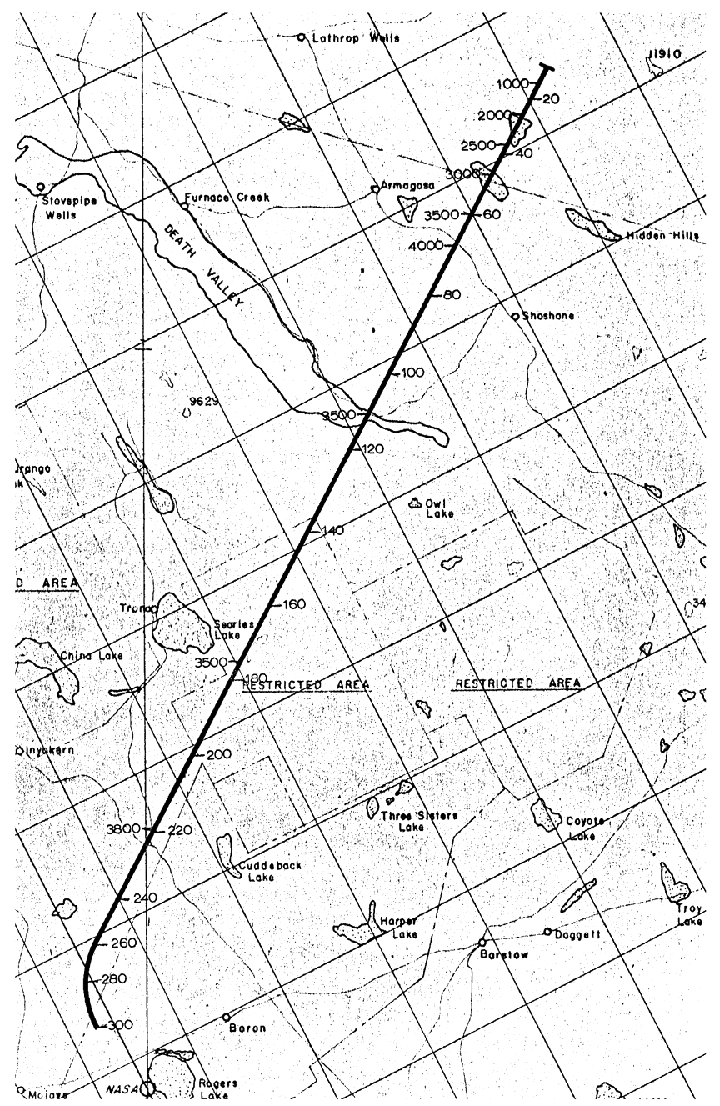Flight No.: 3-3-4 Date: 27 Mar 62
Pilot: Neil Armstrong
Subject of test: Evaluation of MH-96 MS at high and low dynamic pressure (Qmax » 1200 psf, Qmin » 10 psf).
Airplane configuration: Basic X-15-3 with XLR-99 and MH-96 FCS
Launch: Hidden Hills
on a magnetic heading of 222° with MH-96 FCS on "Adaptive Damper,"
BCS #1 "ON" and FCS Reaction Controls "AUTO."
| No. | Time | Alt | V | a | Event |
| 1. | 0 | 45 | 790 | - | Launch using side stick, adaptive damper and light engine at 75%. After 5 sec increase to 100% and rotate to a » 6°. Do not exceed 3 "g." |
| 2. | 25 | 41 | 2000 | 6 | Trim f and engage f Hold. Maintain a = 6° until q = 35°, then engage q Hold. |
| 3. | 50 | 58 | 2800 | 6 | Extend speed brakes. Depress CSS button momentarily. Trim q = 35°. |
| 4. | 70 | 95 | 4000 | 4 | Shutdown engine. Use CSS to push over to a = 0°, engage a Hold. Trim a = 0°. |
| 5. | 100 | 142 | 3500 | 0 | Perform 3-axis pulses and step inputs. |
| 6. | 148 | 170 | 3100 | 0 | At peak altitude engage q Hold and perform 3-axis pulses and steps as a increases to 15°. |
| 7. | 170 | 165 | 3200 | 15 | At a = 15° engage a Hold and perform yaw pulse and roll maneuver. Then use CSS to reduce a to 10°. |
| 8. | 200 | 130 | 3400 | 10 | Use vernier to trim a = 8°. |
| 9. | 245 | 60 | 2700 | 8 | Close speed brakes and engage CSS, perform turn to High Key. Transfer H2O2 if required and jettison. |
| 10. | 270 | 60 | 1600 | 6 | FCS reaction controls off. Engage fixed gain dampers and perform 3-axis pulses. |
| 11. | 300 | 45 | 1100 | 5 | Engage adaptive dampers and perform center stick trim commands up and down. Repeat using side stick trim commands. |
| 12. | High Key. Check ventral armed and tanks pressurized. | ||||
| 13. | Low Key. Approach speed 300 KIAS. Land at 2-mile marker. | ||||
| 14. | After landing, disengage MH-96. | ||||
| 15. | Before APU shutdown, cycle controls, retract flaps, set stabilizer to zero, push to test ball nose and turn all data off. |
Notes:
2. Duration of flight approximately 9 minutes.
3. Emergency lakes: Hidden Hills and Cuddeback.
2. Inertial platform malfunction in attitudes.
3. Q-ball malfunction.
4. Radio or radar failure.
2. For delayed engine light, proceed as planned but maintain less than 3g during rotation, add 5 sec to speed brake extension time.
3. For radio or radar failure, proceed as planned.
4. For adaptive damper failure to fixed gain damper in any axis, proceed as planned but do not use Hold modes in the affected axis. Attempt to reengage adaptive damper, turn FCS reaction controls to "ON."
5. For total yaw damper failure, proceed as planned. Attempt to reengage damper.
6. For total pitch or roll damper failure, proceed but maintain less than 8° a.
7. For ball nose or attitude failure do not use Hold modes. During power phase push over to 0 g, reduce power to 75%, proceed to Edwards. After shut down, if a available, make normal entry. If a not available, make entry with dh = -15°.
8. For inadvertent engine shutdown prior to:
(a) 50 sec - Return to Hidden Hills.
(b) 50 - 60 sec - Proceed to Cuddeback.
(c) More than 60 sec - Proceed to Edwards.
9. If excessive limit cycle occurs during power phase, reduce to 50% T, disengage dampers, pull up to 8° a, attempt to reengage dampers. Increase power at pilot's discretion. Make entry at 12° a.
10. If excessive
limit cycle occurs during entry, disengage adaptive damper in affected
axis, make entry at 7° a.
